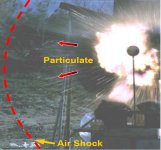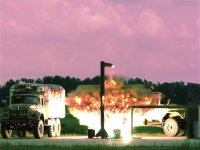Dense Inert Metal Explosive (DIME)
In mid-October 2006 a team of investigative journalists at RAI
Italian television reported that Israel had been using a new weapon in the Gaza 
 Dense
Inert Metal Explosive (DIME) is uniquely suited for Low Collateral
Damage. It produces lower pressure but increased impulse in the near
field. Far Field damage is reduced (no frags/ impulse rolloff). The
lethal footprint can be tuned to precision footprint. Strike Weapon
Scaling Tests were completed in August of 2004), and full-scale Mk-82
tests were in the planning stage as of early 2005. DARPA funded RPG
defense system feasibility tests in January 2005, which were successful.
Dense
Inert Metal Explosive (DIME) is uniquely suited for Low Collateral
Damage. It produces lower pressure but increased impulse in the near
field. Far Field damage is reduced (no frags/ impulse rolloff). The
lethal footprint can be tuned to precision footprint. Strike Weapon
Scaling Tests were completed in August of 2004), and full-scale Mk-82
tests were in the planning stage as of early 2005. DARPA funded RPG
defense system feasibility tests in January 2005, which were successful.
Additional Small Diameter Bomb funding would allow the facilities to continue development of a Focused Lethality Munition (FLM) using the Dense Inert Metal Explosive technology integrated into SDB I. With lawmakers' approval, the dollars would allow AFRL to "continue to mature FLM technology. The armament center would integrate the technology with the SDB I baseline model within the advanced technology demonstration construct and demonstrates utility through a flight test program.
AFRL is currently utilizing high-fidelity physics-based simulations to aid in the design and testing of low-collateral-damage (LCD) munitions. LCD munitions will benefit the warfighter during urban conflicts where standard munitions would inflict unacceptable collateral damage levels. AFRL partnered with Lawrence Livermore National Laboratory to employ a physics-based code in the design and evaluation of the munitions, which are based on a dense inert metal explosive (DIME) technology. The code requires a DIME-specific multiphase flow capability to accurately simulate the DIME-type munitions. The laboratory is continually validating this new capability as the program progresses.
AFRL is utilizing this new capability to assist in the design and validation of LCD weapon concepts. The unique simulations provide the testing community with valuable insight in the areas of weapon detonation physics and blast wave interaction with the test's structural targets. The physical fidelity of the code provides valuable data that allows the researchers to accurately quantify the differences between standard and LCD munitions. This capability allows the team to make timely, informed concept decisions and is more cost effective than trial-and-error testing.
 Increased
attention to the employment of precision weapons has decreased the
occurrence of unintentional collateral damage. Until now, the
development of new munitions to do the same has fallen behind. The
AFRL's Munitions Directorate dense inert metal explosive (DIME) concept
team successfully demonstrated an effective mechanism to reduce
collateral damage, helping the warfighter to prevent the loss of public
support and more importantly, the loss of innocent life.
Increased
attention to the employment of precision weapons has decreased the
occurrence of unintentional collateral damage. Until now, the
development of new munitions to do the same has fallen behind. The
AFRL's Munitions Directorate dense inert metal explosive (DIME) concept
team successfully demonstrated an effective mechanism to reduce
collateral damage, helping the warfighter to prevent the loss of public
support and more importantly, the loss of innocent life.
AFRL encountered survivability problems of conventional air-blast transducers while measuring the close-in blast environment from DIME charges. In 2002, a specially designed Hopkinson bar gauge was utilized to obtain near-field blast measurements from a DIME charge. However, the 2002 tests produced data at only one distance at normal incidence.
AFRL's 20-charge test series in 2004 corrected that problem and produced reflected pressure and impulse data from various distances and angles of incidence, facilitating a lethality analysis of the DIME concept. Scientists used this data to create pressure and impulse maps that detail the near- and far-field magnitudes versus distance and angle of incidence, effectively validating the DIME charge as a low-collateral-damage munition.
The Air Force is demonstrating a low collateral damage warhead, allowing a "behind-the-wall" threat prosecution with a highly localized lethal footprint. The warhead case consists of a low-density, wrapped carbon-fiber/epoxy matrix integrated with a steel nose and base. The low-density composite case can survive penetration into a one-foot hardened concrete wall. Upon detonation, the carbon-fiber warhead case disintegrates into small non-lethal fibers with little or no metallic fragments, thus significantly reducing collateral damage to people and structures. The warhead explosive fill is a dense inert metal explosive containing fine tungsten particles to provide a ballasted payload with sufficient penetration mass. The tungsten displaces energetic material so as to reduce the total energetic used. The net results are higher dynamic energy impulse all within a small lethal footprint.
Previous scaled tests show that the carbon composite casing breaks up into small harmless fibers during the detonation event, effectively removing fragmentation as a lethal mechanism to nearby collateral assets. Thus, near-field airblast with entrained high-velocity inert metal particles are the damage mechanisms for carbon composite cased munitions with DIME fills. Characterization of blast loads from this class of concept munition is essential to verify effectiveness against targets of interest while minimizing collateral damage. Unfortunately, the high-velocity, high temperature inert metal particles found in DIME fills have proved to be extremely damaging to traditional pressure measurement instruments. Hence, new measurement diagnostics had to be developed to investigate DIME formulations.
Previous experiments have demonstrated that specially-designed pressure bar gages outfitted with strain gages were capable of measuring applied blast loads from DIME charges. In 2005, this measurement technology was applied to a series of nine experiments involving full-scale charges with carbon composite casings. Explosive mass and explosive type (two DIME formulations and one conventional high explosive) were varied in the test series. Three pressure bar gages were fielded on each test to characterize the airblast environment produced by each carbon composite cased explosive charge. This paper describes the pressure bar implementation during these experiments, presents results, and comments on the performance of the pressure bars as a measurement diagnostic for this novel class of explosives.

